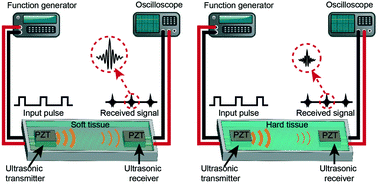A lab-on-chip ultrasonic platform for real-time and nondestructive assessment of extracellular matrix stiffness†
Abstract
Extracellular matrix (ECM) mechanical stiffness and its dynamic change is one of the main cues that directly affects the differentiation and proliferation of normal cells as well as the progression of disease processes such as fibrosis and cancer. Recent advancements in biomaterials have enabled a wide range of polymer matrices that could mimic the ECM of different tissues for a wide range of in vitro basic research and drug discovery. However, most of the technologies utilized to quantify the stiffness of such ECM are either destructive or expensive, and therefore are unsuitable for the in situ, long-term monitoring of variations in ECM stiffness for on-chip cell culture applications. This work demonstrates a novel noninvasive on-chip platform for characterization of ECM stiffness in vitro, by monitoring ultrasonic wave attenuation through the targeted material. The device is composed of a pair of millimeter scale ultrasonic transmitter and receiver transducers with the test medium placed in between them. The transmitter generates an ultrasonic wave that propagates through the material, triggers the piezoelectric receiver and generates a corresponding electrical signal. The characterization reveals a linear (r2 = 0.86) decrease in the output voltage of the piezoelectric receiver with an average sensitivity of −15.86 μV kPa−1 by increasing the stiffnesses of hydrogels (from 4.3 kPa to 308 kPa made with various dry-weight concentrations of agarose and gelatin). The ultrasonic stiffness sensing is also demonstrated to successfully monitor dynamic changes in a simulated in vitro tissue by gradually changing the polymerization density of an agarose gel, as a proof-of-concept towards future use for 3D cell culture and drug screening. In situ long-term ultrasonic signal stability and thermal assessment of the device demonstrates its high robust performance even after two days of continuous operation, with negligible (<0.5 °C) heating of the hydrogel in contact with the piezoelectric transducers. In vitro biocompatibility assessment of the device with mammary fibroblasts further assures that the materials used in the platform did not produce a toxic response and cells remained viable under the applied ultrasound signals in the device.



 Please wait while we load your content...
Please wait while we load your content...